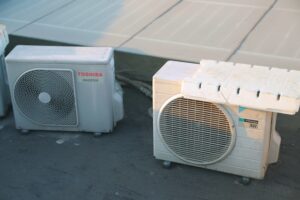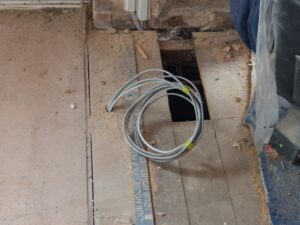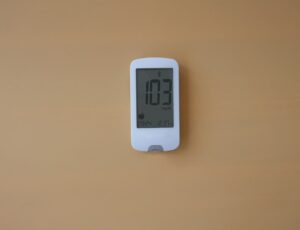Do you ever walk into a room and feel like it’s too hot, while another room is freezing?
Keeping your home comfortable all year round can be tricky, especially when your HVAC system isn’t balanced.
The secret to an evenly comfortable space lies in balancing your HVAC system. When your system is properly balanced, every room gets the right heating or cooling. This doesn’t just make your space feel more comfortable—it also makes your home more energy-efficient.
Picture this: no more hot or cold spots. Just consistent, perfect temperatures wherever you go in your home or office. Adjusting the airflow in your HVAC system ensures that every room gets the attention it needs.
Not only does this improve your comfort, but it also saves you money.
Why?
Because it allows your HVAC system to distribute heating and cooling more effectively, cutting down on energy waste and reducing those high utility bills.
At Excel Mechanical, we make sure your HVAC system works perfectly for your space. Whether you’re looking for a new system or need a tune-up, our team is here to provide solutions tailored to your home or business. We pride ourselves on delivering top-quality HVAC and plumbing services, ensuring your environment stays comfortable and efficient all year long.
In this blog, we will talk about:
- The importance of HVAC system balancing in maintaining consistent comfort throughout your home or office.
- How balancing your HVAC system can help you save money on energy bills.
- Why Excel Mechanical is the right choice for balancing your HVAC system and enhancing your home or business’s efficiency.
Here is all you need to know!
Fundamentals of HVAC System Balancing
Balancing your HVAC system ensures even temperatures throughout your home or building. This process involves adjusting airflow to make each room comfortable and efficient.
Defining HVAC System Balancing
HVAC system balancing is the process of adjusting and testing your HVAC system to ensure even distribution of air. This means each room gets the right amount of air, making the space comfortable.
Balancing involves checking parts like dampers and diffusers. If your system is unbalanced, some rooms may be too hot or cold.
Proper balancing leads to better energy efficiency and comfort.
Importance of Proper Airflow
Proper airflow improves comfort and lowers energy costs.
Balanced systems help your HVAC work efficiently, saving energy. When every room gets the right amount of air, the system doesn’t have to work as hard.
Good airflow reduces strain on your system, prolonging its life. It also helps maintain air quality by ensuring pollutants are moved out properly.
Tools and Instruments for Balancing
- Balancing requires special tools, such as anemometers, to measure air velocity.
- You might also use flow hoods to check how much air is coming out of vents.
- Technicians also use pressure gauges to monitor system pressure.
A skilled professional will have these tools and the knowledge to use them.
Assessing the HVAC System
Checking your HVAC system is crucial to keeping temperatures even. This process ensures that each part of the system works together efficiently. Proper assessments lead to better comfort and energy use.
Conducting Airflow Measurements
Airflow measurements are key in checking your system.
Start by measuring the airflow at different points using an anemometer. This tool accurately records how much air is moving through your vents. It’s important to compare these readings with the specifications of the HVAC system as designed.
Measure airflow at both supply and return registers. You should also examine the ductwork for leaks or blockages. Too much or too little airflow at any point can result in poor temperature control.
By ensuring your system moves air effectively, you can boost comfort and energy efficiency.
Identifying Airflow Imbalances
Uneven temperatures could be due to airflow imbalances.
These imbalances occur when some areas receive more air while others get less. Investigate these by checking the airflow in different rooms. Look for noticeable differences in temperature or air pressure.
Our team helps pinpoint the areas needing adjustment. Often, adjusting dampers can fix these issues. It’s also wise to inspect for obstructions in your ductwork. Clear ducts mean even airflow and balanced temperatures across your space.
By improving these aspects, your HVAC system will deliver the comfort and efficiency you need. Proper airflow balance ensures all areas in your home or office remain comfortably conditioned.
Methods for Achieving Balanced Airflow
Balanced airflow in HVAC systems ensures comfort by distributing air evenly throughout spaces. You can enhance your system’s efficiency and effectiveness by employing various practical methods.
Adjusting Air Dampers
Air dampers play a crucial role in balancing airflow.
Adjusting them helps regulate air volume and distribution within ducts. You can direct more or less air to specific areas by altering damper positions. This control allows for precise temperature management in different rooms.
Some dampers have levers, while others use screws for adjustment. It’s essential to test different configurations to find the optimal balance.
Regular maintenance is also key. Over time, dampers can get stuck or misaligned, requiring attention to maintain system efficiency.
Balancing by Zone
Dividing spaces into zones can improve temperature control.
Zoning involves creating separate sections served by independent thermostats. This method allows you to control heating and cooling for each zone individually. It’s particularly effective for large buildings with varying heating or cooling needs.
To set up zones, install zone dampers, and use programmable thermostats. These enable flexible scheduling and better energy management.
The benefits include energy savings and enhanced comfort. Zoning means rooms only receive heating or cooling when needed.
Utilizing Variable Air Volume Systems
Variable Air Volume (VAV) systems adjust the airflow to meet changing temperature needs.
Unlike constant volume systems, VAV systems supply air at different rates based on demand. These systems use sensors to monitor and respond to changes in room temperature. As a result, they enhance efficiency and provide consistent comfort.
Installing VAV systems requires expert design and setup. They include several components, such as VAV boxes and controllers, to manage air volume precisely.
Optimization Techniques
Optimizing your HVAC system can help improve comfort and energy efficiency. You can create a more balanced environment by focusing on demand-controlled ventilation and zoning controls.
Implementing Demand-Controlled Ventilation
Demand-controlled ventilation adjusts airflow based on the actual needs of each space.
Sensors detect occupancy and air quality, altering ventilation rates accordingly. This reduces energy waste when spaces are unoccupied.
Installing these systems can lower utility bills while maintaining air quality. This technique is especially useful in commercial buildings where usage varies throughout the day.
Zoning Controls and Modulation
Zoning controls allow different building areas to be heated or cooled separately. This means you can direct conditioned air where it’s needed most.
Using dampers and thermostats, each zone operates independently, providing precise temperature control. This can be particularly beneficial in homes or offices with different occupancy patterns.
Implementing zoning increases efficiency and comfort while reducing energy expenses.
Maintenance and Regular Check-Ups
Regular maintenance is key to keeping your HVAC system running smoothly. It helps maintain even temperatures and reduces energy costs. You can prevent many issues with scheduled tune-ups and by knowing common problems that might arise.
Scheduled Maintenance for System Longevity
Regular maintenance ensures your HVAC system lasts longer and runs efficiently.
- You should schedule check-ups at least twice a year, ideally before summer and winter.
- Changing air filters every 1-3 months is crucial, as dirty filters block airflow. Clean the system’s coils annually to keep it efficient.
- You should also check the refrigerant levels to prevent inefficiencies. Thermostat calibration helps maintain accurate temperatures.
- Listen for unusual noises, which may indicate issues.
Hiring professionals guarantees thorough inspections and adjustments to suit your system’s needs.
Common Issues and Troubleshooting Tips
Identify common HVAC issues to address them quickly. Inconsistent temperatures might mean blocked vents or dirty filters.
Check for leaks in ductwork that could affect airflow. If the system fails to start, see if the thermostat is set correctly or if there’s a power issue.
Noisy systems can indicate worn-out parts or loose components. Regularly lubricating moving parts can help prevent noise, and cleaning coils and identifying clogs can help avoid cooling problems.
Upgrading HVAC Components
Upgrading certain components of your HVAC system can improve performance and efficiency. This helps maintain even temperatures and reduces energy costs. Below, we focus on key upgrades that enhance your system’s functionality and longevity.
Benefits of Advanced Thermostats
Advanced thermostats offer more than just temperature control.
- Smart thermostats learn your habits and adjust settings automatically. This optimizes energy use, saving money.
- Programmable options let you set heating and cooling schedules, ensuring comfort when needed.
- They often come with Wi-Fi connectivity, allowing smartphone control or voice commands. This means you can adjust your home’s climate even when you are not there.
- Another advantage is energy reports. These provide insights into your usage patterns, helping you identify energy conservation methods.
By integrating these, you enhance comfort and efficiency.
Installing High-Efficiency Filters
Filters do more than clean the air.
High-efficiency filters improve air quality by removing allergens and dust, which is essential for those with allergies or respiratory concerns. These filters also protect your system. They reduce wear and tear by keeping dust from settling in your equipment. This leads to fewer repairs and extends the life of your HVAC components. They may have higher upfront costs, but they save money on energy bills and maintenance over time.
It’s essential to choose the right filter for your system.
Energy Efficiency and Sustainable Practices
Efficient HVAC systems help save energy and costs. Optimizing energy use includes using smart equipment to recover and utilize energy effectively and choosing renewable sources. These methods aid in sustainability and support eco-friendly living.
Incorporating Energy Recovery Ventilators
Energy Recovery Ventilators (ERVs) are essential for boosting efficiency in HVAC systems.
They capture heat or coolness from indoor air before it’s expelled and use it to pre-condition the incoming air. This reduces the energy needed to heat or cool the air, saving money and improving comfort.
By installing ERVs, you maintain indoor air quality while minimizing energy use. They work best in environments with extreme temperature differences between inside and outside air. Look for models with a high Energy Efficiency Ratio (EER) for maximum benefit.
Leveraging Renewable Energy Sources
Renewable energy, like solar or wind power, substantially increases your system’s sustainability.
Solar panels can power your HVAC system, reducing your reliance on non-renewable energy. Although the initial setup may be costly, the long-term benefits and savings are significant.
Wind energy is another option. Installing small wind turbines can effectively complement energy needs, though it depends on location and wind availability.
Choose our services to meet specific needs and budgets with top-tier professional care.
Educating Occupants and Training Staff
Balanced HVAC systems help maintain even temperatures. Educating occupants and training maintenance staff are vital for system efficiency.
The Role of Occupants in System Performance
Occupants play a key role in the performance of HVAC systems.
Understanding their impact can lead to more consistent temperatures. Simple steps like keeping vents clear and reporting issues can make a big difference. Encourage everyone to set their thermostats to recommended settings and avoid frequent adjustments. Awareness and communication are essential.
Regular reminders and easy-to-follow guidelines will empower individuals and ensure a more comfortable environment. Our professional team ensures that both residential and commercial spaces maximize comfort efficiently.
Developing Skilled Maintenance Teams
A well-trained maintenance team keeps systems running smoothly.
Focus on regular training and updates to provide a strong skill set. Staff should be adept at troubleshooting and performing routine checks. Knowledge in areas like filter changes and duct inspections is crucial.
Provide easy-to-access resources and encourage hands-on learning. Developing local expertise ensures reliable performance. Excel Mechanical stands out for its dedication to quality. Our services offer a balance between expertise and cost-effectiveness, effectively meeting diverse needs.
A trained team prevents issues, reduces downtime, and enhances comfort. Your investment in skilled staff pays off in long-term efficiency.
Legal Compliance and Standards
Ensuring your HVAC system operates correctly requires meeting various legal standards. These regulations cover everything from safety protocols to environmental guidelines. This helps keep air quality high and makes your system energy efficient.
Following HVAC Codes and Guidelines
HVAC systems must adhere to specific codes to function safely and efficiently. These codes outline how systems should be installed and maintained. ASHRAE Standards are widely followed, providing essential system design and performance guidelines.
Understanding local building codes is crucial. They ensure your HVAC system complies with laws and geographic needs. Regular updates to these codes mean you may need frequent checks to stay compliant. Ignoring them can lead to fines or inefficient systems.
It’s important to work with a trusted expert like Excel Mechanical. Our team knows these guidelines inside out, ensuring your system complies and performs optimally for your space and budget.
Safety Protocols and Environmental Regulations
Safety is vital in HVAC installation and operation.
Protocols ensure equipment functions properly without putting people at risk. Carbon monoxide detectors, regular vent inspections, and system checks help maintain safety.
Environmental regulations aim to minimize pollution and improve energy efficiency. These laws cover refrigerant types and disposal methods.
Following these rules helps protect the environment, reduce carbon footprints, and conserve energy.
Frequently Asked Questions
Balancing your HVAC system can make a world of difference when it comes to comfort and efficiency. Here are some common questions to help you understand the process better:
How can air balancing improve HVAC system efficiency?
Air balancing ensures each room receives the right amount of air, making your system run more efficiently. It also reduces energy costs by preventing hot and cold spots and ensuring even temperatures throughout your space.
What is the typical procedure for balancing airflow in an HVAC system?
The process usually involves assessing airflow, adjusting dampers, tweaking fan speeds, and ensuring appropriate vent settings. Technicians use specialized tools to measure air pressure and flow to make precise adjustments.
Which tools are essential for accurate HVAC air balancing?
Key tools are anemometers, manometers, and air balancing hoods. These tools help measure airflow rates and pressures, ensuring a precise balance for comfort and efficiency.
What factors influence the cost of professional HVAC balancing services?
Costs can vary depending on the system’s size, complexity, and the number of adjustments needed. The expertise and reputation of the service provider also affect pricing.
Can homeowner adjustments effectively balance an HVAC system, or is professional service required?
You can make minor adjustments, such as opening or closing vents. However, professional services like those from Excel Mechanical are recommended for optimal results, as we provide precise and effective adjustments.
Are there any DIY methods for balancing temperatures across different rooms in a house?
To help balance room temperatures, you can try closing off vents in less-used areas and using fans to help circulate air. Also, regularly check and change filters. While these methods can help, Excel Mechanical offers professional solutions tailored to your needs and budget.




